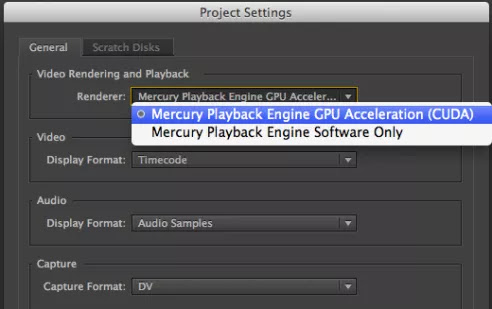

- #ADOBE PREMIERE OPENCL BENCHMARK HOW TO#
- #ADOBE PREMIERE OPENCL BENCHMARK PDF#
- #ADOBE PREMIERE OPENCL BENCHMARK DRIVER#
- #ADOBE PREMIERE OPENCL BENCHMARK PRO#
- #ADOBE PREMIERE OPENCL BENCHMARK FREE#
For advice on that, see video from Adobe's Dave Helmly, like 4K in Premiere Pro with Thunderbolt on HP (or by Dell in PVC webinars). Only going beyond basic HD flavors to 4K or RAW formats might be challenging for recent computer hardware. For Mac-oriented results, see After Effects CS6 CUDA/RAYTRACE Benchmark Chart (and project) from Danny Princz, Chris and Trish Meyer on Adobe Premiere Pro and Multiple GPUs, and testing by Adobe's Dave Helmly below. Other sites provides more information if you love details on performance, like Premiere Pro Benchmark for CS6 & beyond and Windows-oriented threads on the Adobe PP Hardware Forum, both organized by Harm Millaard.
#ADOBE PREMIERE OPENCL BENCHMARK HOW TO#
Studio 1 Productions seems to keep their extensive list of working preference hacks updated: see How to Unlock Adobe Premiere to use almost any NVIDIA graphics card with CUDA acceleration. In early 2013, a MacBook Pro with 8GB RAM by far bested a comparable but low cost 8GB ASUS gaming portable, at least until the ASUS was upgraded to 16GB of RAM.Ī favorite Todd Kopriva quote is about setting for optimal performance: “Because compositions and computer systems vary greatly, there is no one right answer to this question.” Systems differ more than just the graphics cards of course. Also, OpenCL is closer to parity, and you can get reasonable performance even on an older 27″ iMac with AMD Radeon 6970M. It's easy to get good playback acceleration with most CUDA 1GB cards, supported or not, though render speeds vary greatly. Some were qualified by Adobe, but several were not. I've used several Nvidia cards on vanilla PCs and only once was performance an issue, and that was due to a motherboard issue.
#ADOBE PREMIERE OPENCL BENCHMARK DRIVER#
Since the CUDA raytracing feature in AE is quite slow, even those with the most expensive compatible Nvidia graphics cards won't find much use for them, though other considerations matter (other apps and several plug-in vendors accelerate with Nvidia cards).Īt this point, the most pressing issues might be getting the right Nvidia driver onto your Mac, or on Windows determining what computer and components you should buy for Premiere Pro or After Effects – and there's a FAQ for that. For people using Premiere more than 3D programs, the important consideration is Mercury Engine acceleration in Premiere with Nvidia or AMD GPUs, which lets Premiere work in HD in real time. Product Manager Steve Forde shared the basics in How to Optimize After Effects CS6 for High Performance:Ĭreative Cloud brought expanded GPU features using technology available on a wide number of GPUs, as explained by Todd in GPU (CUDA, OpenGL) features in After Effects CS6 and After Effects CC and in OpenCL and Premiere Pro CS6. Some of the details are superseded with new features but there's still much there for beginning and intermediate users, like Isolating what you're working on:ĬS6 brought a big new feature set, the Global Performance Cache ( tutorial roundup), a group of technologies that include a global RAM cache, a persistent disk cache, and a new graphics pipeline.
#ADOBE PREMIERE OPENCL BENCHMARK FREE#
The same year, Todd Kopriva released his free After Effects & Premiere Pro Performance Workshop, videos on how to optimize your tools and system for maximum speed. In early 2011, Adobe hosted a similar one-hour session on optimizing for Premiere Pro and After Effects.

The central information hubs are optimizing for performance: Adobe Premiere Pro and After Effects by Todd Kopriva (2011) and Improve performance in After Effects Help. This is the first Adobe video on the subject for Creative Cloud, though there a large number of support documents on the topic, as well as videos from other recent versions. Chris and Trish Meyer helped revise that document and posted additional results in Adobe Premiere Pro and Multiple GPUs, on how to “get a significant speed boost using a variety of hardware solutions.”

#ADOBE PREMIERE OPENCL BENCHMARK PDF#
There's also a pleasing new PDF guide summary for this info on Adobe video apps. You can review the performance webinar now. Presented by Todd Kopriva (After Effects QA) and Steve Hoeg (Premiere Pro engineering manager), the session covers how CPU, graphics cards, and RAM affect performance, as well as platform-specific considerations, including the new Mac Pro. Adobe offered a free webinar, Optimizing your system for peak performance with After Effects & Adobe Premiere Pro, on February 27, 2014.


 0 kommentar(er)
0 kommentar(er)
